Teaching Strategies
Helping Kids Understand the Black Lives Matter Movement

At BrainPOP, we are devastated and deeply disturbed by the senseless murder of George Floyd and many other Black Americans. We stand in solidarity with the Black community in declaring that Black Lives Matter and we are inspired by the thousands upon thousands of people coming together to demand justice in protests across the country and around the world.
Just like adults, young people are trying to make sense of what is happening in their world. Understandably, they have lots of questions! Because every BrainPOP movie is inspired by a real question, we’ve been receiving tons of email from families and teachers with questions from kids! Here are a few:
Dear Tim and Moby, Why did a police officer kill George Floyd in Minneapolis?
Dear Tim and Moby, I’m hearing stuff on the news about riots for racial equality. I thought that stuff was over with? I’m confused.
My son asked, “What is the Black Lives Matter movement?” Can you add a kid-friendly movie to the site?
In support of our mission to empower kids to shape the world around them and within them, we produced a new movie—Black Lives Matter Protests.
The movie provides context for the ongoing protests, as well as background on the movement. Its development was made possible by the invaluable insight, expertise, and feedback of several key advisors: Dena Simmons, activist, educator, and author of the forthcoming book, White Rules for Black People; Renae Williams, COO & Co-leader at BLEND Employee Resource Group; and Christy Crawford, Director of Culturally Responsive/Sustaining Education & Equity Initiatives at Computer Science For All.
We strongly suggest parents, caregivers, and teachers preview the movie before watching it with children as it describes acts of racist violence. While we don’t advise this movie for younger students, you can find collections of free, age-appropriate topics that support antiracism on both BrainPOP and BrainPOP Jr. Please note we are committed to expanding these collections in the coming months.
Our hope is that the Black Lives Matter Protests movie opens the door to challenging and essential conversations at home and in the classroom, as well as inspires action. We understand that these discussions may not be easy, but silence is not an option. Silence allows racism to thrive.
Following are some suggestions from Dr. Jean Schlegel Ph.D., a New York-based clinical and school psychologist, to guide you on how to begin these important discussions and how to keep them going:
Creating a Safe Space
Create a space that is safe for kids to reflect on their emotional responses to the recent tragic events. Start by asking what they’ve heard. Focus on themes they understand, such as fairness and empathy. You can point out that George Floyd was not treated fairly and in our school/family, we believe everyone should be treated fairly.
It’s okay not to have all the answers. But it’s important to recognize that upsetting events are happening and this is a safe space to talk about it, listen to one another, and learn how we can change things. For more ideas on how to create a safe space for reflection, see Facing History and Ourselves.
Talking About Race and Racial Identity
Children, like adults, see skin color. Even from a young age, they’re aware of these kinds of differences. It’s essential to acknowledge race even if you think it doesn’t impact your family because it does, in fact, affect everyone. When we discuss identity—and encourage kids to take pride in who they are and respect the differences in others—we empower them to stand up to racial injustice. Talking about these issues with children also allows us to show how they can disrupt inequality and combat systemic racism. Talking about race is not racist. It’s important!
White parents tend to avoid conversations about race with their children much more frequently than Black parents and other people of color, according to the study “Identity Matters” conducted by Sesame Workshop and NORC at the University of Chicago. There are multiple reasons why this may happen. Perhaps some white parents feel ill-equipped to have the conversations. Or they want to shield their kids from conversations about race. Or they worry about their own biases—that it’s better to pretend that race doesn’t exist. They think their kids will be happier and less racist if they don’t talk about it.
Regardless of the reason, avoiding these discussions has negative consequences. For example, it places an undue burden on Black families because it means the people who are experiencing the effects of racism are the only ones talking about it—and the only ones advocating for change.
The Child Mind Institute, in their article Racism and Violence: How to Help Kids Handle the News, makes these four suggestions for engaging in conversations about race with your child:
Be clear, direct, and factual about current events and history. Emphasize that racial violence is wrong.
Encourage questions even if you can’t answer them. It’s okay to acknowledge that this is a difficult topic and that you are uncomfortable, but it’s not a reason to stop talking.
Don’t hide your emotions. Letting your child know you’re sad and angry about injustice is good modeling of human behavior that can assure them that it’s okay to express their feelings.
Keep the conversation open. Racism and violence are important topics that require ongoing dialogue. Let your kids know that you’re always available to talk, and be sure to keep checking in on them, too.
From the Child Mind Institute
Being Antiracist
“Black Lives Matter” doesn’t mean that only Black lives matter. It means that racism unfairly affects Black lives—the Black Lives Matter movement is calling on everyone to change that. Even if the intention is sincere, help your child understand that the phrase “All Lives Matter” implies that the BLM movement’s critique of systemic racism and its effects on Black people is invalid. For more teacher support on this topic, see Dena Simmons’ article, How to Be an Antiracist Educator. For more family support, read “6 Reasons ‘All Lives Matter’ Doesn’t Work—in Terms Simple Enough for a Child” from Parents.com.
Racial colorblindness is the idea that NOT seeing color is a good thing; that race shouldn’t matter. But, in fact, it does the opposite. When we don’t recognize race, we perpetuate racial misunderstandings and we erase the specific lived experience of those affected by racism. For a truly antiracist society to exist one day, it’s essential to be aware of and talk about race. We can’t afford to be silent.
Giving Young People Hope and Empowering Them to Speak Up
Acknowledge kids’ anxieties and fear, but also reassure them that many people are working very hard to change things and keep them safe. It’s important to give children hope. We can give them hope by offering tools to work with. Explain that mass protest movements—from Civil Rights and Women’s Suffrage to Black Lives Matter—have historically been able to change institutions and systems. Assure them that society can continue to improve. Empower young people by encouraging them to use their voice and actions to participate and make a difference. They can stand up for their friends and classmates, write letters, and engage in adult-guided activities—like fundraisers.
Since BrainPOP’s earliest days, we’ve helped kids understand difficult subjects, from September 11th to Coronavirus. By building background knowledge about challenging topics, we prepare and equip them to have critical conversations. To that end, BrainPOP is committed to developing additional new topics to help children, families, and teachers have necessary conversations about racism and identity.
For more on BrainPOP’s thoughts and response to recent events, read the letter from our CEO which includes a link to a blog post featuring our free resources for supporting antiracist education.
Additional writing by Tamara Fisch.






